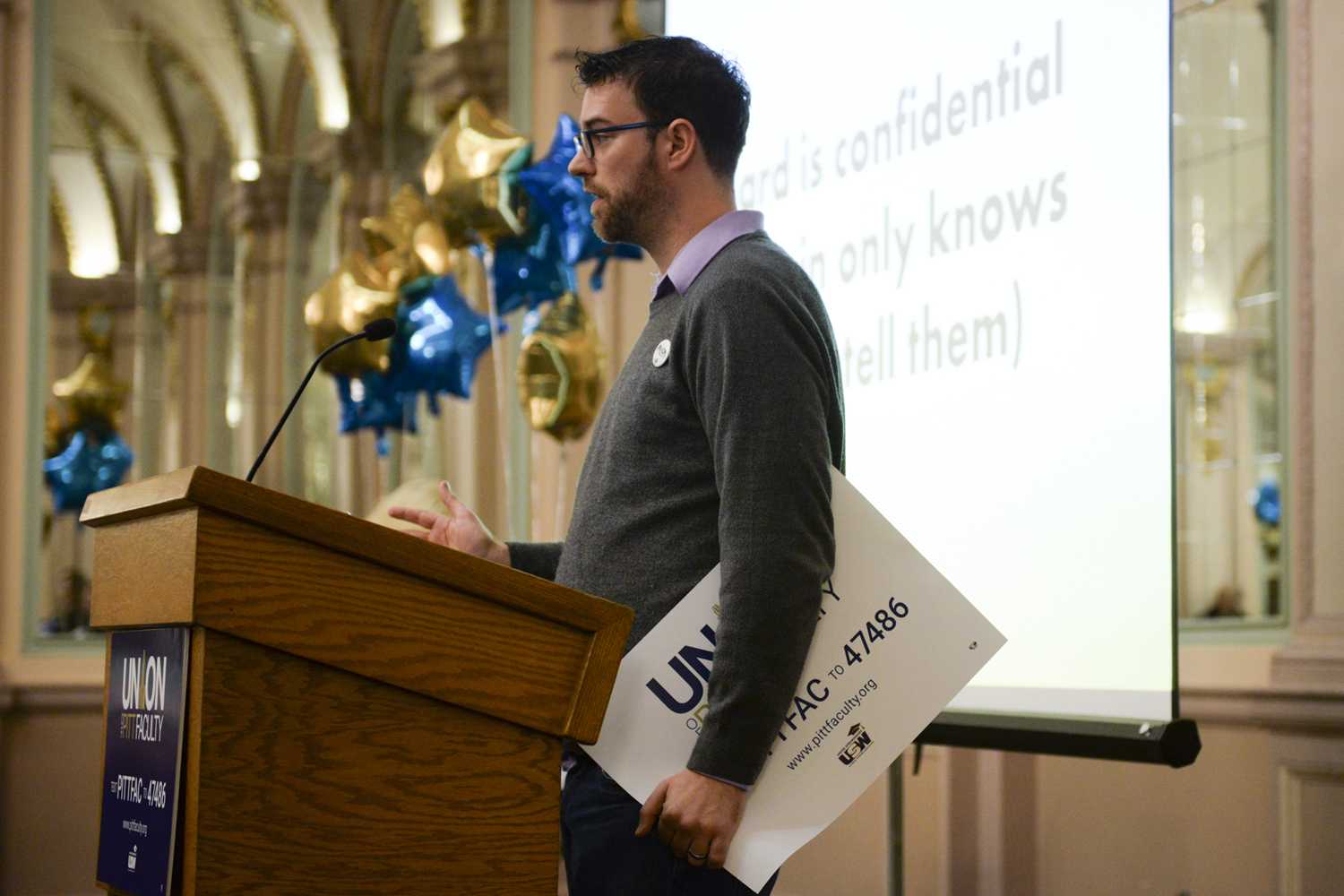Part 3 | Faculty union organizers’ next steps


Paul Johnson, a faculty union organizer and Pitt communications professor, gives information about the union’s progress to about 50 people in the William Pitt Union Ballroom in January 2018.
This article is the final part of an in-depth series about Pitt’s faculty union campaign. Read from the beginning here.
Forming a faculty union at a Pennsylvania university actually isn’t too complicated — in theory.
Organizers have a year to collect signed authorization cards from 30% of faculty, which Pitt’s organizing team submitted to the Pennsylvania Labor Relations Board in January. Next, the university provides the board with a list of faculty eligible for the bargaining unit, which Pitt did in March. Then, if there are no disagreements about the size of the bargaining unit, the board schedules an election where at least 50% of eligible faculty who vote must vote “yes” to form a union.
But that’s a big “if.” For Pitt’s faculty union campaign, the process has been riddled with delays caused by hearings, appeals and legal disputes over who should be included in the union, before faculty even have the chance to vote “yes” or “no” on whether to form a union.
“We’re at the stage where everything starts to get complicated,” organizer Tyler McAndrew said in July.
Pitt’s lawyers and the United Steelworkers organizing counsel are now deep in debate about who should be included in the bargaining unit, and Pitt has until Nov. 1 to turn over employment records to organizers, under the hearing examiner’s orders.
The PLRB has scheduled another round of hearings for Dec. 2-4, where organizers will once again challenge hundreds of inclusions, this time with employment records in hand.
Graphic by Gennadi Ryan | Online Visuals Editor
“Our [list of] challenges may change a little once we get the documents,” USW Organizer Robin Sowards said. “Basically we need to see which semesters people were paid in … to determine if they’re eligible.”
According to precedent set by Temple University, the most relevant precedent for Pitt’s faculty union, faculty must have taught in the last two semesters to be eligible for the bargaining unit. Part-time faculty who teach during only one semester each year must have taught at Pitt in both of the past two years.
“The [employment] contracts would show us that better than any public record,” Sowards added.
Those December hearings will also address disputes about whether the medical school should be included in the faculty union — Pitt favors the medical school’s inclusion, whereas organizers remain firmly opposed. A 1990 PLRB decision ruled that Pitt’s medical school was a separate bargaining unit due to its deviant funding and employment structure. Adding the medical school to Pitt’s faculty union would double the size of the bargaining unit.
PLRB representatives declined to say when they plan to rule again on whether organizers collected enough authorization cards to prompt a union election, but Sowards suspects it’ll happen next spring, after Pitt’s lawyers and union organizers hash out their disagreements at the December hearings.
“If we say the bargaining unit is 3,500, which was our original estimate, then we got more than enough cards [to prompt a union election],” Sowards said.
Still, even if organizers prevail on the next “showing of interest” ruling, Pitt could appeal the decision to the Commonwealth Court and, subsequently, the State Supreme Court. The path to a union election could take as little as six months, or be drawn out for years with heavy litigation.
“At any point, the administration could just stop stonewalling and sit down with us to reach an [agreement] about who should be in the unit,” Sowards said. “Then the hearings would be completely superfluous.”
Because Pitt’s using every legal tool at its disposal to “stall a union election,” organizers say they believe they’ll have to take the circuitous route to unionization. But Sowards said dragging out the unionization process won’t bode well for Pitt once faculty have a union — the administration will only have succeeded in “pissing everyone off.”
“You obstruct a union vote, you’re obstructing democracy,” Sowards said. “If [the administration] cares about their faculty, they should just let the faculty vote.”
Read the rest of this series:
Recent Posts
Notes From an Average Girl // Notes on Book Banning
In this edition of Notes From an Average Girl, senior staff writer Madeline Milchman writes…
To Be Honest // Yup, it is that damn phone
In this edition of To Be Honest, staff writer Evin Verbrugge writes about her phone…
Meaning at the Movies | Portraying Toxic ‘Adolescence’
In this edition of Meaning at the Movies, staff writer Lauren Deaton explores the mini-series…
Opinion | Climate change requires radical, immediate action
Contributing editor Emma Hannan talks about the effects of climate change and the actions cities…
Jaland Lowe enters transfer portal, becomes fifth Panther to jump ship
On Tuesday morning, it was announced on X that Pitt sophomore guard Jaland Lowe was…
College Democrats and Republicans debate pressing political topics
Around 100 students gathered to watch Pitt’s College Democrats and College Republicans debate a variety…

